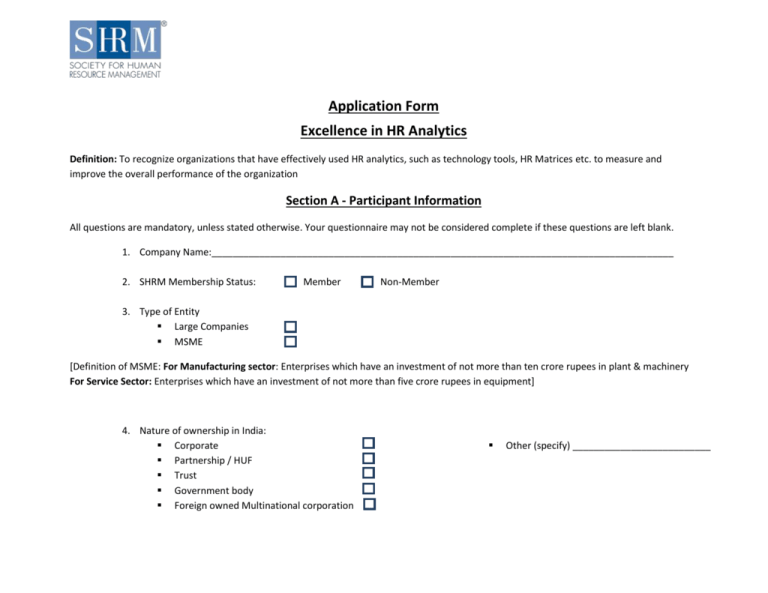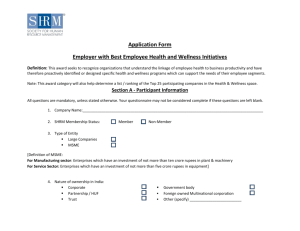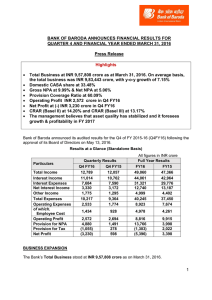Excellence in HR Analytics
advertisement

Application Form Excellence in HR Analytics Definition: To recognize organizations that have effectively used HR analytics, such as technology tools, HR Matrices etc. to measure and improve the overall performance of the organization Section A - Participant Information All questions are mandatory, unless stated otherwise. Your questionnaire may not be considered complete if these questions are left blank. 1. Company Name:_______________________________________________________________________________________ 2. SHRM Membership Status: Member Non-Member 3. Type of Entity Large Companies MSME [Definition of MSME: For Manufacturing sector: Enterprises which have an investment of not more than ten crore rupees in plant & machinery For Service Sector: Enterprises which have an investment of not more than five crore rupees in equipment] 4. Nature of ownership in India: Corporate Partnership / HUF Trust Government body Foreign owned Multinational corporation Other (specify) __________________________ 5. Date of Incorporation in India (dd-mm-yyyy): ____-____-____ 6. Revenues, as of FY 2014-15 (please tick in the relevant box below) < INR 50 crore per year INR 50-200 crore per year INR 200-500 crore per year > INR 500 crore per year 7. Number of Employees (as on 31st March, 2015): __________________________ 8. Details of SPOC (Single Point of Contact): This could be the CHRO or relevant Functional Head. Name: _________________________________ Designation: ____________________________ Contact number : ________________________ Email address : __________________________ Postal address : __________________________ 9. HR Metrics: Metrics Employee Growth Rate Gender Ratio Average Employee Age Group Value added per employee (e.g. EBIDTA per employee) Attrition Rate Offer Drop % FY 2013 FY2014 FY 2015 No. of Mandatory Trainings (Technical Skills) No. of Mandatory Trainings (Soft Skills) Revenue Growth (%) Profit Growth (%) Employee Engagement Scores Customer Satisfaction Scores Total People Investments (INR) including: Total amount spent on employees (Salaries, Benefits, Taxes, Health insurance etc.): Total amount spent in support of employees (Real estate, communications, supplies, IT etc.): Total amount spent in lieu of employees (Leasing company expense, temp workers, costs related to outsourcing etc.): Total amount invested in training & development (Learning cost, travel cost, non-salary development costs etc.): Management/Leadership Quality Leadership engagement scoresAn index based on results from a set of relevant questions on an employee survey. The Leadership Quality index should be based on a set of survey questions that cover issues such as: Example: Vision - do leaders promote a convincing shared vision? Alignment - are leaders providing clear direction that link individual efforts to strategic direction? Drive for success - do leaders push to achieve challenging 'stretch' goals? Collaboration - do leaders create a collaborative atmosphere and listen/ take inputs from employees Innovation - are leaders open to new ideas Section B – Quantitative Measurements This section covers the quantitative aspects of the initiatives under the concerned category. We strongly recommend providing all the information that has been asked for, under this section as it will enhance your nomination and aid the jury in better evaluation of your application. Glossary of key terms used: FY: Financial Year FY 2015: First quarter of year 2015 Executives: The top three tiers of your organization i.e. the CEO, Executive Board (or equivalent) and first level reports (does not include Nonexecutive directors). If reporting for a business unit, data should represent the highest parent entity of your organization, not the senior team in any business unit or country of operation. Senior managers (Middle management) Level of experience: 8- 15 years First level managers (Junior Management) Level of experience: 0-8 years Others: All staff who do not have any people managerial responsibility (i.e. no one reporting to them) Cost of Human Capital: All direct and indirect spend on Human Capital in your organisation Net profit per employee: Net profit after taxes / total number of FTE Return on Investment on your Human Capital: Investment = Revenue – (Expenses - Cost of Human Capital) Cost of Human Capital Cost of Human Capital to the total operating cost (Direct and Indirect spend) FY 2013 % FY 2014 % FY 2015 % Please specify the components that you have taken into consideration to account for total human capital cost: Net profit per employee (PAT) FY 2013 FY 2014 FY 2015 ROI on Human Capital Investment (revenue less total expenses less human capital expense)/human capital expenses) FY 2013 FY 2014 FY 2015 Ratio of HR professional to all employees FY 2013 FY 2014 FY 2015 What are the reasons for the changing ratio, if any? Cost of total annual employee turnover FY 2013 FY 2014 FY 2015 What is the rate of annual turnover in your industry? : ___________________ Cost of Annual voluntary turnover FY 2013 FY 2014 FY 2015 Average cost per hire FY 2013 FY 2014 FY 2015 Average benefit cost per employee FY 2013 FY 2014 FY 2015 Employee absentee rate FY 2013 FY 2014 FY 2015 Cost of employee absenteeism FY 2013 FY 2014 FY 2015 Expenditure on HR technology and tools FY 2013 FY 2014 FY 2015 What is your current and planned technology enablement of the below mentioned HR processes, in your organization? HR Process Talent Acquisition & People Flows Learning and Development Performance Management Compensation & Rewards Career/Succession Planning Payroll Attendance & Leave Administration HR Record Keeping Currently technology enabled/ supported Plan to technology enable in next 12 months Plan to technology enable in next 18 months No plans for technology enablement currently Remarks/ Comments On which of the following do you track and present metrics as part of your HR Dashboard to the management? HR Process Talent Acquisition & People Flows Learning and Development Performance Management Compensation & Rewards Career/Succession Planning Payroll Attendance & Leave Administration HR Record Keeping Do not have specific metrics Have specific metrics and track them List of specific metrics that are tracked Section C - Qualitative Measurements Qualitative measurements are based on initiatives that have been implemented or are ongoing in the organization. These would allow for understanding and evaluating the nature of initiatives, the issues which were addressed by these initiatives, the impact on stakeholders and efforts to sustain these initiatives. What were the key issues/challenges faced for which an innovative initiative was required? [Key pointers –Integration of HR analytics, alignment of HR strategy, contribution of human capital, employee productivity levels, employee turnover, employee absenteeism etc.] Describe the initiatives that emerged to address the above-mentioned issues/challenges and their key objectives [Key pointers –HR dashboard set-up, applying HR technology, integrating Human Capital analytics, educating stakeholders on HR analytics, measurement of employee productivity and efficiency etc.] How did you assess the effectiveness of the initiatives undertaken and what were the results? [Key pointers –ROI on Human capital, cost per hire, comparison with industry benchmarks, profit per employee, rate of customer satisfaction, rate of product development, change in quality levels etc.] What impact have your initiatives had on your key stakeholders? [Key pointers –Enhanced organizational performance, improved competency levels, developed HR analytics orientation, leadership effectiveness, employee satisfaction etc.] What are the key factors that are required for the initiatives to sustain and grow over the next few years? [Key Pointers – Financial and people investments, adaptation of HR analytics, updating of HR systems, HR analytics training programs, dynamic HR policy etc.] Please use the space below to add any further details/information








